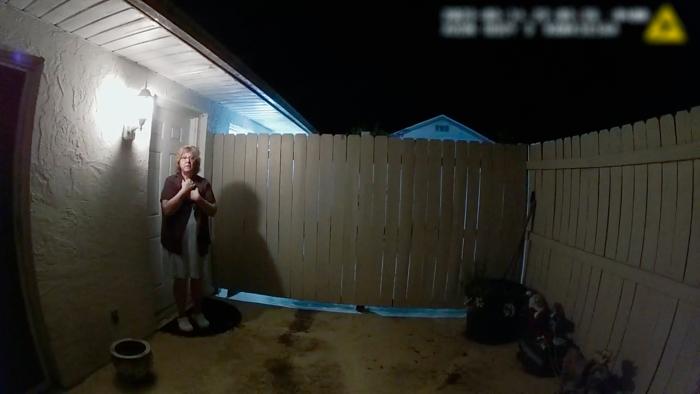By Alison Lanier | Film | October 20, 2025

The Perfect Neighbor is an Oscar contender hiding among the deluge of streaming true crime content. It landed on Netflix for its general release after a limited run (and taking home the Sundance 2025 U.S. Documentary Directing Award, and landing on the DOC NYC Short List).
It’s a documentary in the most basic sense of the word: primary documents (in this case, footage) woven into a narrative. Director Geeta Gandbhir builds the story through roughly 95% body cam and Ring cam footage, without narration. As far as I know, it’s the first of its kind. And given the story it’s telling, the uniquely intimate sense of witness—particularly from a police perspective—feels brutally poignant.
What we’re bearing witness to is the killing of Ajike “AJ” Owens, a 35-year-old mother of four in the tight-knit community in Florida. Owens, who was Black, was shot and killed by her white neighbor, 58-year-old Susan Lorincz. The killing was pointless, cold-blooded, and heavily laden with very overt racism.
The case made headlines in 2023, when Lorincz invoked Florida’s “stand your ground” laws to defend shooting Owens through a locked metal door. This is after calling the police almost daily on Owens’s and others’ (mostly Black) neighborhood kids playing football on a lot adjacent to her home. Call after call, we watch as the police try to manage Lorincz’s clearly baseless complaints while also trying to mitigate tensions with the neighbors.
When Lorincz manufactures a situation where she has the chance to pull the trigger (after recently googling “stand your ground” laws, by the way), the night unfolds on screen from the perspective of the police’s body cam footage. It is, needless to say, horrific to watch. While the violence itself isn’t shown, the frantic aftermath is, including Owens’s young children waiting with their dying mother and learning that she had passed. The captions during these sequences include things like “[Cries in anguish].” It really does feel unspeakable. And we dwell in that moment with them. Are you hurt, asks one first responder to Owens’s ten-year-old son, who witnessed the shooting. His response—No, but my heart is broken.
Gandbhir calls the film “grief work,” and the grief for her was personal: her husband’s family was close with Owens. These aren’t documentary subjects to her, they’re friends. She told IndieWire: “The making of the film, because […] I don’t know how to do anything else, was what I had to offer the family, and also a way of processing.”
The literal perspective of the materials makes it intimate, immediate, and brutal. So too is Susan Lorincz’s racism. It’s so profoundly, painfully clear-cut in her treatment of the Black children in her neighborhood. You don’t feel threatened by ten-year-old children, call them jackasses, and hurl the n-word at them if you aren’t a grade-A bigot. The crime’s nuance comes, to me, in Lorincz’s privilege as a white woman. She wasn’t arrested after she killed Owens but was instead taken to a hotel. The police gave her permission to come back and retrieve her cats. She sits placidly and tells the police she doesn’t think the n-word is racist—it just means someone is dirty or unlawful. She wouldn’t have called the kids that if she thought it was racist. It’s the kind of rancid bullshit that only flies when someone doesn’t expect to be challenged—because the police must be on her side, right? She was in fear for her life, after all. All evidence to the contrary shouldn’t matter, apparently, because she’s the real victim here. This Black woman was shouting at her. So.
After the utter horror of what the viewer has just experienced—children have just watched their mother shot, and their father sits down and explains to them that their mother isn’t coming back—watching Lorincz’s indignant complaints to the police in the interrogation room, her easy turning of the narrative into one in which she had to defend herself … It’s stomach turning. And then she walks out of the station, and the police give her a ride to a hotel.
The treatment she received and the potential lack of legal consequence under Florida’s “stand your ground” laws feel as senseless and baffling as her viciousness toward the children and her remorseless crime.
The good news: she doesn’t get away with it. The film closes with a damning glimpse of her trial, in which we have the sense of the truth falling on her like a righteous ton of bricks.
The film is intimate, painful, vital, and messy. I think only a family friend could have made this documentary in a way that didn’t feel invasive, instead grieving with and for the Owens family. It’s an important story told at close range and without the option to look away during the most devastating moments.